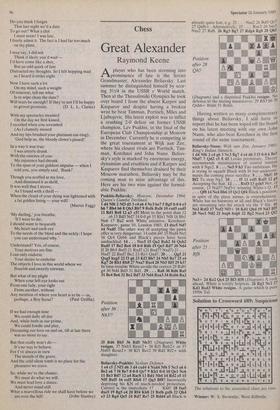Chess
Great Alexander
Raymond Keene
Aplayer who has been storming into prominence of late is the Soviet Grandmaster, Alexander Beliaysky. Last summer he distinguished himself by scor- ing 31/2/4 in the USSR v World match. Then at the Thessaloniki Olympics he took over board 1 from the absent Karpov and Kasparov and despite having a broken wrist he beat Timman, Portisch, Miles and Ljubojevic. His latest exploit was to inflict a crushing 2-0 defeat on former USSR champion, Lev Psakhis, in the final of the European Club Championship at Moscow in December. Currently he is competing in the great tournament at Wijk aan Zee, where his closest rivals are Portisch, Tim- man, Korchnoi and John Nunn. Beliav- sky's style is marked by enormous energy, dynamism and erudition and if Karpov and Kasparov find themselves drained by their Moscow marathon, Beliaysky may be the coming man to seize advantage of this. Here are his two wins against the formid- able Psakhis:
Psakhis-Beliaysky: Moscow, December 1984; Queen's Gambit Declined.
1 d4 N16 2 Nf3 d5 3 c4 e6 4 Nc3 be7 5 Bg5 0-0 6 e3 h6 7 Bh4 b6 8 Qb3 Bb7 9 Bxf6 Bxf6 10 cxd5 exd5 11 Rdl Re8 12 a3 cS! More to the point than 12 . . . c6 13 Bd3 Nd7 14 0-0 g6 15 Rfel Nf8 16 Bbl Ne6 17 Bat with White initiative, Korchnoi- Kasparov, game 10, London 1983. 13 dxc5 Nd7 14 NxdS The other way of accepting the pawn offer is very dangerous: 14 cxb6 d4! 15 Nxd4 Nc5 16 Qc4 Qxb6 and Black'spieces have been unshackled. 14 . . . NxcS 15 Qa2 Bxb2 16 Qxb2 Bxd5 17 Be2 Re6 18 0-0 Rd6 19 Qe5 Rd7 20 Nd4 If 20 Bb5 Bxf3 21 Rxd7 (21 Bxd7? Nxd7) 21 . . . Nxd7 22 Bxd7 Be2 23 Rel Qxd7. 20 . . . Qg5 21 QxgS hxg5 22 13 g6 23 Kf2 Bb7 24 Nb5 Re7 25 e4 Kg7 26 Rhl Rh8 27 Nxa7 Bxe4 28 Nb5 Bf5 29 h3? In time-trouble White avoids the correct 29 Rd6! g4 30 Nd4 Bd3 31 Bdl. 29 . . . Ra8 30 Rd6 Ra5 M Bc4 Be6 32 Be2 Bd7 33 Nd4 Rxa3 34 Rxb6 Ra2
Position after 36 . Nb3!!
35 Rd6 Bb5 36 Rd5 Nb3!! (Diagram) White resigns. 37 Nxb3 Rexe2+ 38 Kfl Reb2+ or 37 .Nxb5 Rexe2+ 38 Kfl Rec2 39 Rdl Rf2+ with slaughter.
Beliaysky-Psakhis: Sicilian Defence.
1 e4 c5 2 Nf3 d6 3 d4 cxd4 4 Nxd4 Nf6 5 Nc3 a6 6 Be2 e6 7 f4 Be7 8 0-0 Qc7 9 Khl 0-0 10 Qel Nc6 11 Be3 Bd7 12 a4 RacS 13 Rdl Nb4 14 Rd2 e5 15 Nf5 BxfS 16 exf5 RfeS 17 Qg3 Bt8? Incorrectly depriving his KN of much-needed protection. Correct is the immediate 17 . . Kh8! 18 fxe5 dxe5 19 Bg5 e4 20 Rf4 Kh8 21 Bxf6 gxf6 22 Qh4 e3 23 Rg4 Qe5 24 Rd7 Re7 25 Rdd4 a5 Black is already quite lost, e.g. 25 . . . Nxc2 26 Rd5 Qc7 27 Qxf6+. Alternatively, 25 . . . Rxc3 26 bxc3 Nxc2 27 Rd8. 26 Rg3 Bg7 27 Rdg4 Rg8 28 Qh5
Position after 28 Qh5
(Diagram) and a dispirited Psakhis resigns. No defence to the mating manoeuvre: 29 Rh3 h6 30 Qxh6+ Bxh6 31 Rxh6.
Having written so many complimentary things about Beliaysky, I still have to report that he has been wiped off the board on his latest meeting with our own John Nunn, who also beat Korchnoi in the first
round of the same tournament.
Beliaysky-Nunn: Wijk aan Zee, January 1985; King's Indian Samisch.
1 d4 N16 2 c4 g6 3 Nc3 Bg7 4 e4 d6 5 f3 0-0 6 Be3 Nbd7 7 Qd2 c5 8 d5 Looks premature. Theory recommends maintenance of central tension with 8 Nge2. 8 . . . Ne5 9 h3 Too ambitious. He is trying to squash Black with f4 but underesti- mates the coming piece sacrifice. 9 . . . Nh5! 10 Bf2 To stop Ng3. 10 . . . f5 11 exf5 Rxf5 12 g4 Accepting the bait. 12 . . . Rxf3 13 gxh5 Not, of course, 13 Nxf3? Nxf3+ winning White's Q. 13 . . . Qf8 14 Ne4 Bh6 15 Qc2 Qf4 Black's position, in spite of the piece minus, is overwhelming. White has no harmony at all and Black's forces are streaming into the attack via the 'f file. 16 Ne2 Rxf2 17 Nxf2 Nf3+ 18 Kdl Qh4 19 Nd3 20 Necl Nd2 21 hxg6 1146 22 Bg2 Nxc4 23 (212 Position after 25 . . . Rf8 Ne3+ 24 Ke2 Qc4 25 B13 Rf8 (Diagram) A rook ahead, White is totally helpless. 26 Rgl Nc2 27 Kdl Bxd3 White resigns. A game which is pure 1950s Tal.










































 Previous page
Previous page